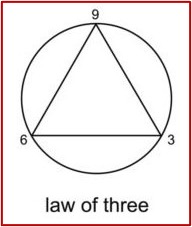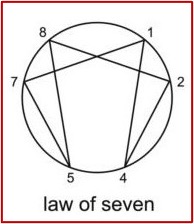
The Enneagram, or the Enneagram of personality, seems to be everywhere these days. Within the Christian church, it is marketed as a method of spiritual enlightenment, a tool for personal transformation and development, and a fusion of psychology and spirituality. Christian publishers have fallen over each other to publish books on using the enneagram for becoming more like Jesus; uncovering your true, God-given self; and finding your unique path to spiritual growth. And yet, it is rooted in occult practices and has similarities to Gnostic, Eastern and New Age beliefs.
Brandon Medina, writing in “The Enneagram — A History (Part 1)” for Theology Think Tank, said the Enneagram is alleged to be a tool that helps the person who uses it to discover their Enneagram number, which supposedly represents both the person’s personality and the area of in the person’s life that is hindering their spiritual development. “The number defines and identifies who you are and where you struggle.” This description refers to the modern sense and use of the Enneagram, the Enneagram of personality, but the Enneagram itself has earlier, and some claim, even ancient sources.
Most scholars and writers attribute the origin of the Enneagram to George Ilych Gurdjieff, who introduced the Enneagram image to the West in 1916. Gurdjieff suggested he borrowed the symbol and its philosophy from “ancient sources.” In the above linked article, Medina traced Gurdjieff’s vague references of the origins of the Enneagram back to a possible Babylonian origin. He said: “We could continue along the bunny trails and down the rabbit holes in an attempt to find an exact origin but I believe the information above is enough to at least point to a far ancient though unspecific beginning which is anything but Christian or biblical in origin.”
Gurdjieff and the Enneagram
Gurdjieff was an Armenian mystic who taught esoteric spiritual philosophies based on knowledge he gleaned from his journeys, which he described in Meetings with Remarkable Men. In “The Enneagram — A History (Part 2),” Medina said Gurdjieff was influenced by several religions: Christianity, Buddhism, Hinduism and Sufism. His teachings aimed at the transformation of humanity’s inner substance and he emphasized secrecy and confidentiality within his groups. Gurdjieff believed that so-called ‘normal’, non-esoteric psychology was at such variance with what was involved in reaching a higher level of awareness, “that his students would only retard their own progress and stir up hostility and misinterpretation by discussing the work of the group outside of it.” Marcia Montenegro said in “The Enneagram GPS,” that “Gurdjieff held that man is not aware of true reality and needs an awakening of consciousness.” Medina quoted Gurdjieff as saying:
The knowledge of the enneagram has for a very long time been preserved in secret and if it now is, so to speak, made available to all, it is only in an incomplete and theoretical form of which nobody could make any practical use without instruction from a man who knows.
Gurdjieff believed there have been three traditional modes of transposing our identity from the temporal (bound by time and space) to the immortal. They were the way of the fakir (the way of struggle with the physical body); the way of the monk (the way of faith, the emotional way); and the way of the yogi (the way of knowledge, the way of mind). He concluded that while these work, they only work by severe asceticism and seclusion, which are not feasible to achieve in a modern society. His answer to this problem was the Fourth Way, which works on all three: body, emotions and mind at the same time in order to achieve balance. In Gurdjieff Unveiled, Seymour Ginsberg explained:
As we become more balanced, we can be self-conscious more easily because we are less identified with our body, our thoughts, or our emotions. When we no longer identify with these features of temporal life, we discover that we are free of all fears and all desires. We then stand in essence, not in personality, and essence is immortal.
 The philosophical foundation of the Fourth Way is the Law of Three and the Law of Seven. The basic structure for the Law of Three is that for every action there are three required forces: active, passive and neutral. Gurdjieff called these forces affirming, denying and reconciling. They correspond to the triangle within the Enneagram as follows: affirming or active force (6), the denying or passive force (3) and the reconciling or neutral force (9). Christian mystics see imagery of the Trinity within the Law of Three; Hinduism sees Brahma, Shiva and Vishnu; Alchemy sees mercury, sulfur and salt. Until the third force interacts with the first two, nothing happens. Ginsburg said:
The philosophical foundation of the Fourth Way is the Law of Three and the Law of Seven. The basic structure for the Law of Three is that for every action there are three required forces: active, passive and neutral. Gurdjieff called these forces affirming, denying and reconciling. They correspond to the triangle within the Enneagram as follows: affirming or active force (6), the denying or passive force (3) and the reconciling or neutral force (9). Christian mystics see imagery of the Trinity within the Law of Three; Hinduism sees Brahma, Shiva and Vishnu; Alchemy sees mercury, sulfur and salt. Until the third force interacts with the first two, nothing happens. Ginsburg said:
We can think of this process as movement along a parabola. The ‘descending’ arc of the parabola represents the ‘descent’ of spirit, an infinitely rapid, vibratory state, which represents infinitely fine matter, into grosser and grosser states until at the bottom of the parabola there is an infinitely slow vibratory state, which represents infinitely dense matter. The return arc of the parabola represents just the opposite, the ‘ascent’ of matter into spirit. It is sometimes called the path of return (to unity). Gurdjieff called human beings, ‘third-force blind,’ and this is because the third force is a property of the real world, the world as seen from the standpoint of Endlessness in complete non-identification. The real world can be experienced only in the state of objective consciousness. It is the fourth state of consciousness of which we are not conscious but toward which we work. It is the state in which we are completely free of all identification.
In contrast to the Enneagram of personality, notice that Gurdjieff intends for you to detach from your personality, not find it.
The Law of Seven or the Law of Octaves dives deeply into music and music theory. “While the Law of Three is one of forces, the Law of Seven is one of scales on which cosmic and global laws are attached.” Most people who use the Enneagram are unaware that each of the points are tones on the octave you move through before moving on to the next. “The law of octaves involves the complete process of the note ‘do’ going through a succession of tines until it reaches the complete process of the note ‘do’ of the next octave. The ‘do’ must pass through 7 tones which represent the Law of Seven.”
 The so-called experts of the Enneagram wrongly ask people, or tell them through test results, what their enneagram number IS. They believe this number has a static, unchanging value. For example, in “How the Enneagram System Works” the Enneagram Institute mistakenly claims “that people do not change from one basic personality type to another” and “no type is inherently better or worse than any other.” These claims are the opposite of what was taught about the Law of Seven by P.D. Ouspensky, a student of Gurdjieff. When he introduced the Enneagram to Ouspensky, Gurdjieff said: “In order to understand the enneagram it must be thought of as in motion, as moving. A motionless enneagram is a dead symbol; the living symbol is in motion.”
The so-called experts of the Enneagram wrongly ask people, or tell them through test results, what their enneagram number IS. They believe this number has a static, unchanging value. For example, in “How the Enneagram System Works” the Enneagram Institute mistakenly claims “that people do not change from one basic personality type to another” and “no type is inherently better or worse than any other.” These claims are the opposite of what was taught about the Law of Seven by P.D. Ouspensky, a student of Gurdjieff. When he introduced the Enneagram to Ouspensky, Gurdjieff said: “In order to understand the enneagram it must be thought of as in motion, as moving. A motionless enneagram is a dead symbol; the living symbol is in motion.”
When the Law of Three and the Law of Seven are combined with their lines of connection by the numbering sequences of each, the Enneagram in its final form is produced. The 3, 6, and 9 lines represent the Law of Three; and the 1, 4, 2, 8, 5, 7 lines represent the Law of Seven. Gurdjieff said, “The Enneagram is the fundamental hieroglyph of a universal language which has as many different meanings as there are levels of men.” He added:
All knowledge can be included in the enneagram and with the help of the enneagram it can be interpreted. And in this connection only what a man is able to put into the enneagram does he actually know, that is, understand. What he cannot put into the enneagram makes books and libraries entirely unnecessary. Everything can be included and read in the enneagram.
Yet, the Enneagram Institute disagrees, saying:
Although the Enneagram is probably the most open-ended and dynamic of typologies, this does not imply that the Enneagram can say all there is to say about human beings. Individuals are understandable only up to a certain point beyond which they remain mysterious and unpredictable. Thus, while there can be no simple explanations for persons, it is still possible to say something true about them. In the last analysis, the Enneagram helps us to do that—and only that.
Medina concluded that unfortunately for Gurdjieff the Enneagram has been popularized as a personality test that helps you discover who you are and who you can be, and “not as a tool to reveal the future of all knowledge.” Today it is a journey of self-discovery that helps you uncover your true, God-given self and your unique path to spiritual growth, rather than an explanation of all things in the universe. In Part 2 of this article, we’ll look at “The Enneagram — A History (Part 2)” by Brandon Medina and see how the Enneagram became the Enneagram of personality.





